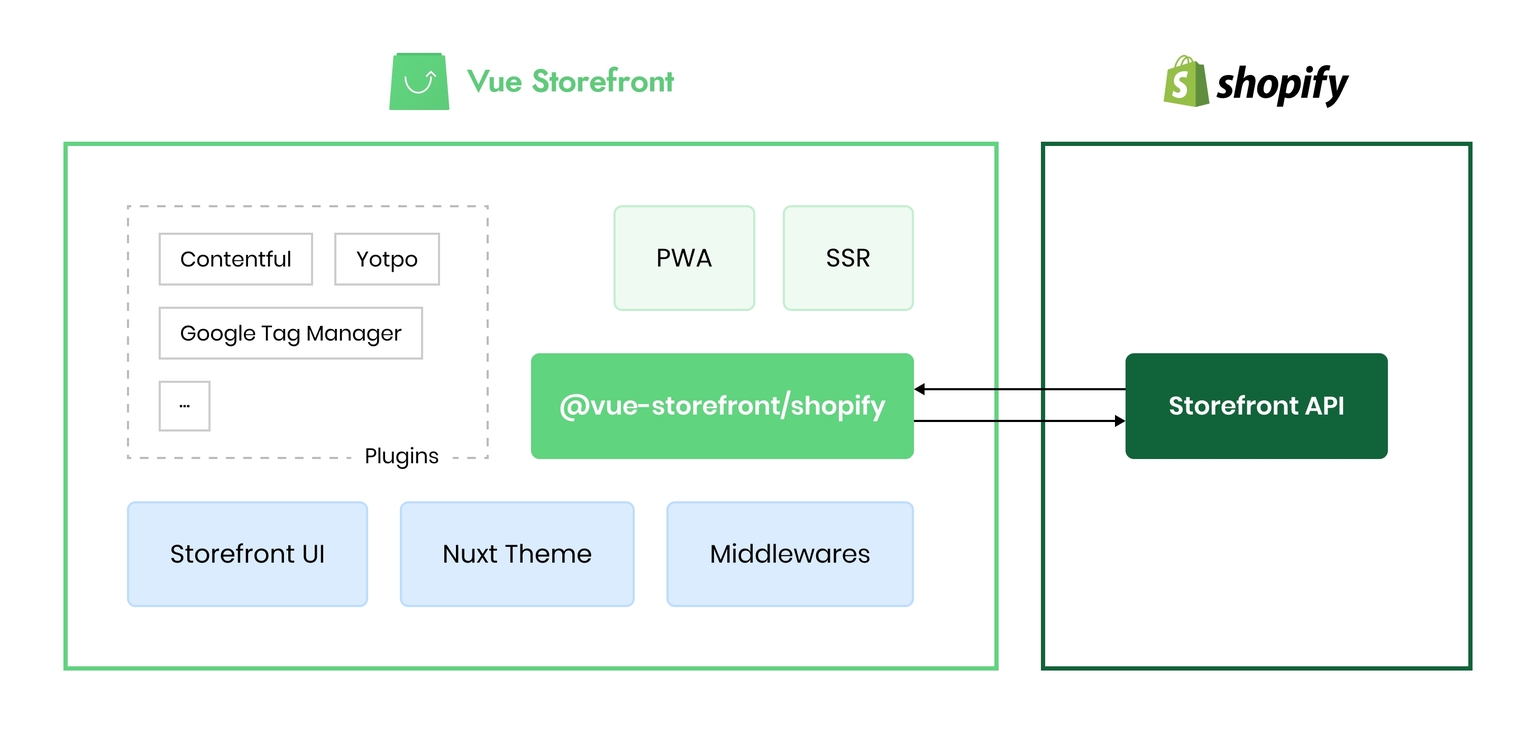Although many countries have opened physical trading in 2021, eCommerce continues to skyrocket. Numerous brick-and-mortar store owners are either moving their business online, opening it up, or adding digital channels to traditional ones. Recent stats show that Shopify is often chosen as a tech stack. This platform, especially among small and medium-sized businesses, is compelling, but - on the other hand, Headless Commerce benefits are also tempting for them. Is there a way to combine it?
Shopify's market position
According to a report by Builtwith, Shopify's market share in the US is 23%, with over 1.4 million online stores based on it. Interestingly, Shopify is a leader in many industries - such as automotive, sports, grocery, and healthcare, so its offerings meet the needs of various businesses. It is currently the third-largest eCommerce platform in the world, and its position is still growing.
<blockquote class="twitter-tweet"><p lang="en" dir="ltr">Some figures from <a href="https://twitter.com/hashtag/ShopifyUnite?src=hash&ref_src=twsrc%5Etfw">#ShopifyUnite</a>: more than 820K merchants are currently using <a href="https://twitter.com/hashtag/Shopify?src=hash&ref_src=twsrc%5Etfw">#Shopify</a>, making it the 3rd largest online retailer in the US. More than 25.8 million apps have been installed, with 80% of these being third-party apps. There are clearly many opportunities ahead! <a href="https://t.co/1kWEfWeI7m">pic.twitter.com/1kWEfWeI7m</a></p>— Tomas Kacevicius (@intred) <a href="https://twitter.com/intred/status/1141527349193842688?ref_src=twsrc%5Etfw">June 20, 2019</a></blockquote> <script async src="https://platform.twitter.com/widgets.js" charset="utf-8"></script>
Shopify Values
Start in just a few hours
Virtually immediately after registration and a set of basic settings, you'll have a store that's ready to start selling. All you need to do is fill in the basic details, customize the template, add products and integrate with shipping and payment systems, and your store can go live. The same goes for migrating the store from another platform.
Intuitive to use for non-technical users
It's easy to navigate the admin console, customize functionality, and process orders. It is a big plus for teams that focus on sales development without investing in technical facilities. It also allows new employees to be introduced to the business more quickly.
Uncompromised security
Complies with PCI DSS, 3-D Secure authentication, and protects customer data from loss. And you do not have to set it up yourself. Shopify takes care of security for you, and you do not have to worry about compliance.
Flexible mobile-first design
Shopify provides you with dozens of templates that you can easily customize to fit your brand. You add a logo, change colors and fonts, change the page layout, add sections, videos, photos, and opinions. You also have the option to create your own unique Shopify design from scratch.
Extensive App Store
If you plan to add additional features to Shopify, you can find a suitable plug-in at Shopify App Store. There are tons of apps for sales, marketing, and customer service. The community around Shopify is so large that new solutions are being developed all the time. However, if you can not find a ready-made solution, you can always create your own.
Sales support and omnichannel
Selling online faces many challenges, such as increasing the value of a cart, preventing it from being abandoned, or attracting a customer to your store. Shopify works to simplify these things. The result is integrated cart recovery options, data analytics, and ads management from the Shopify dashboard.
Shopify's partnerships
Literally, anyone can use Shopify. You do not need any technical knowledge to build your eCommerce business as it is user-friendly. In terms of business size, Shopify is best suited for small and medium enterprises.
Shopify opens up the opportunity for these businesses to take advantage of global players’ reach to facilitate sales and increase credibility in customers’ eyes.
Thanks to the integration with Google, sellers to sign up with just a few clicks to have their products appear on Google's multichannel services such as search engines, maps, graphics, lenses, and YouTube.
It fits with Shopify's approach of looking at eCommerce as a holistic sales ecosystem, not just as a channel. Of course, the platform remains the main channel, but Shopify wants to extend its possibilities by joining forces with others.
Shopify limitations
Are there any downsides of Shopify, though? At some point in scaling the business, the Shopify limitations in customizability may come to light. And to be completely honest, it is hardly a truth bomb: all SaaS platforms are easier to use for non-technical users, but it came with limited customization for developers.
You can use it without worrying about hosting, system installation, updates, backups, plug-ins, system extensions, etc., but you can't change a thing in the core code, as it doesn't belong to you.
Sellers have to move within boundaries set by the supplier, and - no matter how large the boundaries are - they may turn out not large enough for big providers interested in introducing individual improvements and adapting the website to specific needs. Smaller players who are into personalized and non-standard marketing activities may also feel a lack of freedom in, e.g., choosing the 3rd party marketing tools.
Shopify's Frontend drawbacks in a nutshell
- Limited control of the visual display of products
- Content management processes are pretty basic
- URL structure is set
- Selling cross border (Its difficult to setup multi-language and multi-currency in Shopify out-of-box)
Is Shopify CMS Headless?
Shopify provides a CMS feature, and for small businesses, it can be good enough. It is easy to use with the rest of its services, such as theme layer or editor. Still, it is not Headless CMS, and - as such - its capabilities, for example, in content delivery, are limited and designed for very basic use cases.
If you want your content to go beyond basic use cases: make them more personalized, more in line with your marketers' team, business needs, and target group, more up-to-date - headless CMS, and in general - Headless Commerce - is a go-to direction.
Headless Commerce benefits
Headless Commerce seems to be an answer for the challenge. Separated concerns make it much easier to customize the system and adjust it to the current business needs. Companies that implemented headless strategies can publish changes to the store interface much faster, change the store interface much more extensively, and experiment with non-standard solutions.
In addition, headless commerce frontend solutions ensure that the website works smoothly on all devices, and - thanks to the connection with Headless CMS - it separates the marketers' works from devs'.
As a result, content designers and marketers gain complete control of what is displayed to users and can make instant changes with no devs' support, and merchants can save tons of time and money as we all know the cost of dev's time.
Sounds interesting? It should, especially that the time whet going headless required building custom-made solutions or entirely re-platforming the system, backed included are basically gone.
What do you gain with headless architecture?
Agile and RTM marketing
Headless Commerce enables merchants to test marketing tools and run non-standard activities. Why? Headless CMS gives the wheel to marketing teams to make them make any instant changes in the content displayed to users. That means they can launch any landing page and run any marketing campaign in days instead of weeks - as they don't need to ask the dev's team for help.
Short time-to-market
Headless eCommerce, or to be precise - separated API-first frontend - extends the possibilities in terms of shaping user experience. The headless approach enables frontend devs to deploy instant updates without jeopardizing the backend system. UI/UX can be constantly updated to keep up with the fast-paced changing consumer behaviors, as merchants are not forced to roll out the update of the entire system when a frontend layer is not coupled to the backend.
Personalized customer experience
As we said above, customer needs are never set once for all, and merchants have to chase them constantly. Still, this ever-changing environment doesn't change the fact that consistent customer experience across all devices and channels is also a must. Within the Headless Commerce system, maintaining it is not a problem. The backend passes the information to the frontend (it "tells" what item the consumer bought). The frontend uses the information to make and showcase personalized offers through mobile apps and social channels. It is possible thanks to Headless CMS and other 3rd party services.
Seamless integrations with 3rd party services
Headless Commerce is built with API in the center, which - by default - ease-out integration with other platforms, tools, and services. That means almost limitless possibilities in terms of customizations: merchants can add and remove them at any given moment, adjusting their system to the current business needs.
Make your Shopify store Headless
Headless Commerce is definitely an exciting choice, especially that the time when going headless required building custom-made solutions or entirely re-platforming the system is basically gone.
Of course, headless platforms - such as commercetools - as a foundation of eCommerce systems remain a perfect choice for enterprise-scale businesses. They open up a way to almost limitless possibilities to “design” the backend of their system and enable them to reflect complicated, multilayered business logic. Still, re-platforming is not the only way merchants can go headless. Actually, the ones who are OK with their platform regarding security, core application logic, and databases, but want to spice a bit their UX, can change just the frontend layer. It saves costs and cuts development time but allows testing the headless approach in practice.
What headless options do you have to choose from?
Building custom solution
First, you can build your very own frontend solution. Creating a custom solution means complete control over the code, which is the main benefit of that approach. There are no limits in expanding that software, so merchants can mold it the way they want, adjusting it to their individual demands.
What are the cons? There is mainly one, but painful: costs. Building an eCommerce system from scratch is challenging and time-consuming, and creating a headless eCommerce system based on API is even more difficult. When choosing that approach, merchants must be prepared for long time-to-market and often unpredictable costs.
Using a Frontend-as-a-Service
Typically, the pros and cons of reaching out to solutions available on the market are reverses: less control in exchange for quick time-to-market. It is pretty natural, as the time needed for research, design, build the fronted is already covered (when you decided to go with the agency - also a time of deployment and testing).
Merchants get an out-of-the-box package that covered every eCommerce feature they need, and they don't have to reinvent the wheel, which saved time and money. But what about the above-mentioned less control? Well, it can be the case when in-depth architectural elements of the stack will be beyond your reach, and changes will need to be discussed with the provider.
Using the open-source solution
The open-source solution seems to e a nice balance between the ones above: there is no vendor lock-in, so basically, you own the code and can do whatever you want with it, but a package of ready-to-integrate eCommerce features is at your disposal.
Headless Shopify with Alokai, a Bodiless Frontend
Going back to Shopify - you can keep all the fantastic backend benefits Shopify delivers, but - at the same time - gain all the benefits of headless:
- increase site speed,
- improve customer experience,
- retake control of URL structure,
- choose the Headless CMS that separates works of the development team from the marketers
- take advantage of all PWA features, etc.
There are at least a few ways to make Shopify headless, but - we want to introduce you to the one we know the most about, and it is a Shopify Integration with Alokai made by Aureate Labs.
Aureate Labs, is the Alokai Solution Partner for several years. That agency has a great experience working with the first version of Alokai prepared with Magento in mind. When Alokai 2 came up, they immediately started to work on the Shopify Integration.
They saw - for a good reason - that this platform is excellent in reading eCommerce trends and will be on its wave, as well as Headless Commerce. And two plus two equals Headless Shopify and Bodiless Alokai.
It took several months to make Shopify Integration production-ready. Still, as it kicked off, it really kicked off, as Aureate Labs used Shopify Integration to extend the marketing possibilities of Pure Daily Care, achieving outstanding results. This LA-based beauty and wellness brand transitioned towards headless Shopify mainly because of business reasons. The company had nothing against Shopify backend capabilities, but its frontend had to be better, combining the different sales channels for its customer experience. Shopify’s limitations due to lack of flexibility in shaping UX became a problem, and Bodiless Frontend turned out to be an answer.
Its new site had to be fresh and friendly, able to shape the customer experience according to the modern eCommerce standards across all the possible channels and with all the necessary tools such as - for example - loyalty programs.
It was a must, especially that Pure Daily Care's targeted audience is very tech and social-media savvy, and skincare products have multiple features that had to be presented in a specific - informative but also user-friendly - way.
I had a roadmap in which I mentioned the loyalty program. Still, I also wanted to get quizzes where people can pick their skincare, build bundles on the fly, and much more... I needed to switch things out quickly, and I didn't want the design to fit just the Shopify templates. I want the ability to change the elements of the page myself without having to manipulate a template or risk bringing the site down - Jonathan Cohen, CMO at Pure Daily Care.
The entire process took just eight weeks, and the results were outstanding. Read about it here.
How to get headless with Shopify?
Going headless was the way to break through the limitations of Shopify softly: merchants have total control over the frontend while still using Shopify for the back-office operations. Also, it is still open-source and backed by a vast community of developers. It is a win-win.
But what about technicals?

Alokai is a platform-agnostic e-commerce PWA frontend framework that can work with any e-commerce backend API. Shopify “Integration” is a package that connects Shopify and VSF2 using Shopify’s Storefront APIs. We are using Shopify JS Buy SDK under the hood. This integration is built by keeping developers/agencies in mind. So they can use it as a “base” and add more customizations on top of it, said Piyush Lathiya - CEO - Aureate Labs.
This integration is built by keeping developers/agencies in mind. So they can use it as a “base” and add more customizations on top of it.
What can you get with Shopify Integration?
Building breakthrough Customer Experiences
You can build what matters the most for your customers, adding custom layouts or integrate 3rd party search and filter engines.
Progressive Web App
Shopify integration comes with PWA out-of-the-box.
Personalization
Using open-source Shopify integration, you can customize stores that make most of the sense for your customers. Beyond customization, you can integrate AI-based personalization apps like Nosto or Dynamic Yield.
Cross-border sales
Within Shopify integration, you can use Contentful or Headless CMS and add multiple entries for different languages.
Performance
With the implementation of the API-first strategy, content gets rendered within a fraction of a second.
Control of URL structure
When you go headless with Shopify integration, you can define custom URL structure as per your need.
What is the cost of going headless with Shopify Integration?
Typically, headless projects are more expensive than normal Shopify entities. Still, Alokai can save your time and money on implementation costs by delivering a fully functional out-of-the-box solution.
Developers can focus on covering 3rd party integrations and custom-made features that are uniquely adjusted to business needs.
What is essential in the case of Shopify <>Alokai Integration, the separated frontend needs to be hosted outside of the Shopify ecosystem. It comes with the costs but will ensure total control and care of by the VSF Cloud experts. Choosing VSF Cloud, VSF DevOps is responsible for server infrastructure, so you don’t need your in-house DevOps engineers.




















Social commerce
Another similar initiative is a partnership with Facebook and the development of Facebook Shops - a free tool that helps merchants create a custom online storefront for Facebook and Instagram. Facebook Shops is one of the most prominent reps of social commerce trends, and Shopify also wants to jump into that bandwagon by joining forces with Facebook.